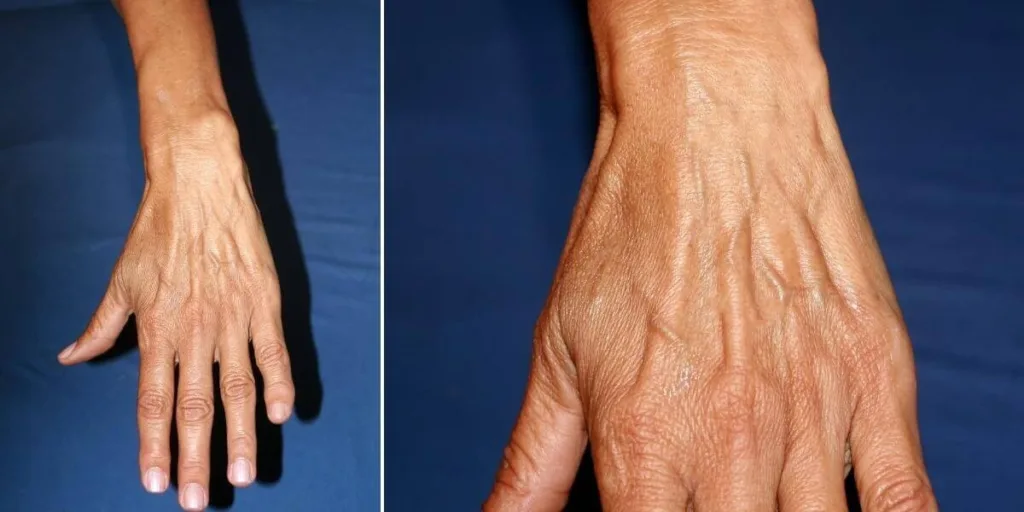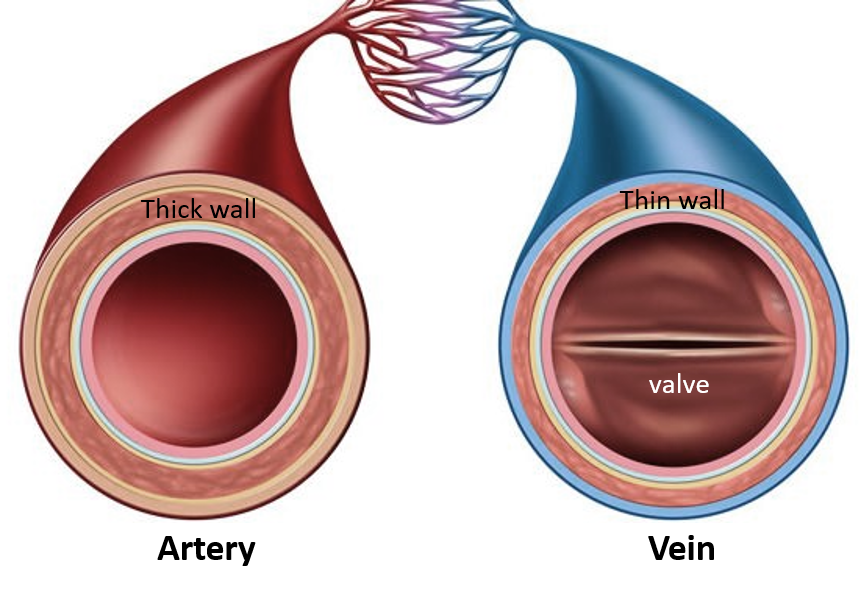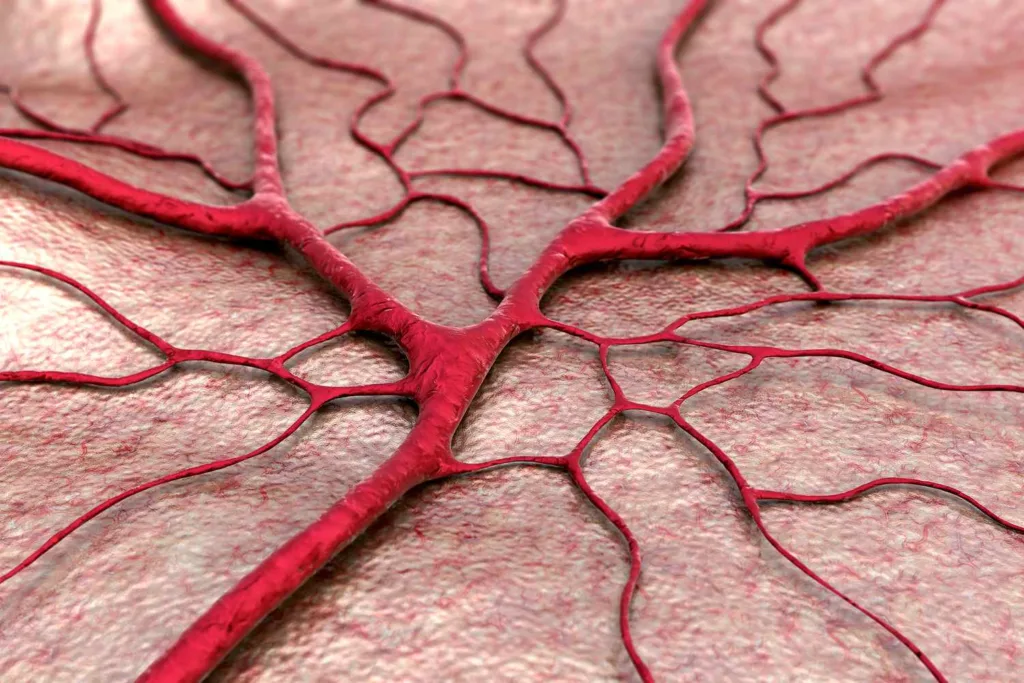Have you ever wondered how the blood vessels in your body connect? Arterioles, venules, and capillaries are responsible for moving your blood around your body. But how do these three blood vessels work together to create the cardiovascular system?
Arterioles are small blood vessels that carry blood away from the heart. They control your blood pressure and flow by changing their diameter using their muscles. They also link to capillaries to exchange oxygen, nutrients, and waste.
Venules are very small blood vessels that connect capillaries with veins throughout the body. Their main function is to move blood with waste and without oxygen from capillaries to veins. From there, it can make its way back to the heart.
Capillaries are the smallest and most abundant of all the blood vessels in the body, connecting arteries that carry blood away from the heart with veins that return it back to the heart. These tiny tubes connect arterioles with venules so that oxygen-rich and nutrient-filled arterial blood can be exchanged for deoxygenated venous blood containing carbon dioxide and othr metabolic wastes.
Finally, a metarteriole is an arteriole directly connected to a venule, providing a vascular shunt which allows capillary beds to be bypassed. This is important because it allows for quick exchange of fluids between different areas of the body without having to go through all of the capillary beds first.
In summary, arterioles, venules and capillaries work together as part of our cardiovascular system. Arterioles carry oxygen-rich and nutrient-filled arterial blood away from our hearts while Venules bring deoxygenated venous blood containing carbon dioxide and other metabolic wastes back towards our hearts. Capillaries form bridges between both arterioles and venules allowing for quick exchange of fluids between different areas of our bodies without having to go through all of our capillary beds first. Lastly, metarterioles provide a vascular shunt which allows us to bypass some of our capillary beds when needed!
Connection Between Arterioles and Veins
Arterioles are small arteries that connect directly to veins through a specialized type of blood vessel known as a capillary. Capillaries are the smallest of all the blood vessels, and serve as the link between the arterial and venous systems. They form an intricate network throughout the body, allowing oxygen-rich blood from the arteries to be delivered to cells and allowing oxygen-depleted blood from cells to return to the veins. The walls of capillaries are extremely thin, allowing for efficient exchange of gases, nutrients, and waste products between cells and the bloodstream.

The Connection Between Arterioles and Other Structures
Arterioles are connected to both arteries and capillaries. Arteries are the larger blood vessels that carry oxygen-rich blood away from your heart and towards the rest of your body. The arterioles branch off from these arteries and connect to smaller capillaries, which are tiny tubes that act as bridges between the arterioles and the tissue cells of your body. Through this connection, the arterioles are able to exchange oxygen, nutrients, and waste with the capillaries. This exchange allows for a continuous flow of blood throughout your body and helps to regulate blood pressure.
Connection of Venules
Venules are connected to both capillaries and veins. They act as a bridge between the two, carrying deoxygenated blood from the capillaries to the veins. This allows for the transfer of waste and other byproducts from your tissue cells to be moved away from the area. The veins then transport this material back to the heart, where it can be filtered out of your circulation and expelled from your body.
Connecting Arterioles and Venules Without Capillaries
Channels that connect arterioles with venules bypassing capillaries are known as metarterioles. A metarteriole is a type of vascular shunt, which is composed of a small artery (arteriole) directly connected to a small vein (venule), allowing blood to flow from the arteriole to the venule without passing through the capillaries in between. Metarterioles are typically between 10 and 20 micrometers in diameter and can be found in varius organs, such as the brain, heart, liver, kidney, and lungs. They allow for rapid blood flow from the arterioles to the venules by bypassing the capillary bed. This reduces resistance in the circulatory system and helps maintain tissue perfusion. Additionally, they are thought to help regulate blood pressure by modulating vascular tone.
The Connection Between Arterioles and Veins Through Capillaries
Yes, capillaries connect arterioles to veins. Capillaries are the smallest of blood vessels and form a network throughout the body. They act as a bridge between the larger arterioles and veins, helping to regulate blood flow and pressure. The walls of capillaries are very thin, allowing for the exchange of oxygen and nutrients from the bloodstream to tissues and vice versa. Additionally, waste products like carbon dioxide can move from tissues back into the bloodstream via these vessels.

Joining of Arterioles and Venules
Capillaries join arterioles and venules. Capillaries are the smallest of the blood vessels, and they are responsible for exchanging molecules between tissue fluid and the circulation. They are comprised of a single layer of endothelial cells surrounded by a thin layer of connective tissue. The walls of capillaries are permeable to allow molecules to pass through, allowing oxygen, nutrients and waste products to be exchanged between the circulation and the surrounding tissues.
The Connection Between Arterioles and Capillary Beds
The connection between arterioles and capillary beds is made up of two types of vessels: true capillaries, which branch off from the arterioles and form networks of tiny blood vessels to supply oxygen and nutrients to cells, and vascular shunts, which are short vessels that directly connect the arterioles and venules at opposite ends of the bed. True capillaries are responsible for exchanging oxygen and other important molecules with the surrounding tissue, whereas vascular shunts provide a bypass for blood flow. Together, these two types of vessels make up the connection between arterioles and capillary beds.
The Connection Between the Glomerulus and Arterioles
Yes, the glomerulus is connected to arterioles. These tiny arteries are responsible for carrying blood into and away from the glomerulus, entering and exiting through the open end of the capsule. The arterioles bring oxygen-rich blood to the glomerulus, where it is filtered, before leaving as oxygen-depleted blood. This process allows for the waste products of metabolism to be removed from the bloodstream while allowing essential nutrients to be delivered.
Arterioles: Where Do They Lead?
The arterioles lead to a network of capillaries, which are the smallest vessels in the circulatory system. Capillaries are responsible for exchanging nutrients and waste products between the arterioles and the veins. The arterioles provide small vessels with blood, which then enter into a capillary bed, where exchange of materials occurs. From there, the capillaries merge together to form small venules that collect blood from the capillary beds and direct it back towards larger veins. In this way, arterioles control and regulate blood distribution throughout the body, providing oxygen and nutrients to cells and tissues while removing waste products.
The Connection Between Arteries and Venules
Yes, arteries connect to venules. The arterial system is responsible for transporting blood away from the heart to the body’s tissues. Blood leaves the heart through the aorta and branches into smaller vessels, called arterioles, which distribute oxygenated blood to capillary beds. These capillaries are tiny vessels where exchange of nutrients and waste occurs between the bloodstream and body tissue. After this exchange of materials, the deoxygenated blood flows back into small vessels called venules which then merge toether to form veins and eventually lead back to the heart. Therefore, arteries do connect to venules in order to complete the cycle of circulation in the body.
The Formation of Venules Through the Convergence of Vessels
Venules are the smallest of the veins that collect and transport oxygen-depleted blood away from tissues to eventually empty into larger veins. They form as a convergence of several capillaries, which are microscopic tubes that facilitate the exchange of gasses in the body. Capillaries are formed by a network of tiny blood vessels (called arterioles) that branch off from arteries. The arterioles connect to small clusters of capillaries, which then merge together to form venules. Venules range in size from 0.1 to 0.5 millimeters in diameter and typically carry deoxygenated blood that is on its way back to the heart.
The Difference Between Venules and Arterioles
An arteriole is a small diameter blood vessel that carries oxygenated blood away from the heart to the capillary beds of tissues. The arterioles have thicker walls than capillaries, which helps regulate the blood flow and pressure in the body.
A venule is a small diameter blood vessel that carries deoxygenated blood from capillary beds back to the heart. Venules have thinner walls than arterioles, which allows for a more efficient return of blood from tissues. Venules typically connect to larger veins in order to transport the deoxygenated blood back to the heart.
The Role of Tiny Connecting Bridges Between Arterioles and Venules
Tiny connecting bridges between arterioles and venules are called capillaries. Capillaries are the smallest and most numerous blood vessels in the body, and they have a crucial role in exchanging nutrients, oxygen, and waste products between the bloodstream and tissues. Capillaries have extremely thin walls that allow for the exchange of substances such as glucose, amino acids, hormones, and ions between the blood vessels and tissue cells. They also provide a route for white blood cells to travel to sites of infection or injury. By connecting arterioles to venules, capillaries form a continuous network of circulation throughout the body.
Connections Between Capillaries and Other Vessels
Capillaries are the smallest of all blood vessels, and they are responsible for the exchange of oxygen, carbon dioxide and other gases, nutrients, and waste products between the arteries and veins. They connect arteries to veins by forming a network of thin-walled tubes throughout the body. The walls of capillaries are very thin and porous, allowing a great amount of exchange between them and surrounding tissues. When an artery reaches a capillary bed, it branches off into many small arterioles that then lead directly into the capillaries. The capillaries then merge back togther to form venules before exiting the capillary bed as a single vein.

Connecting Capillary Networks
The connection between one capillary network and another is a portal venous system. In this system, blood flows away from the capillaries in one area to the capillaries in another region without first traveling through the heart. The veins of the portal venous system act as a bridge between two separate capillary networks, allowing for the efficient exchange of fluids and nutrients between different areas of the body.
Conclusion
In conclusion, arterioles and venules are important elements of the circulatory system that work in tandem to maintain proper blood flow and pressure throughout the body. Arterioles are small blood vessels that carry blood away from the heart, while venules are very small blood vessels that connect capillaries with veins. The combination of arterioles and venules also includes metarteriole, a specialized vessel which allows for the bypassing of the capillary bed. All these elements together ensure that oxygen, nutrients, and waste products are exchanged between tissues and organs throughout the body.
